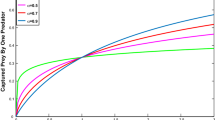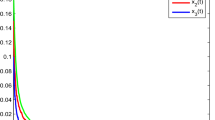Abstract
Environmental noise and infectious diseases are important factors affecting the development of the population. This paper develops a mathematical system to investigate the impacts of environmental noise and infectious diseases on predator–prey interactions. The globally unique positive solution is confirmed by using conventional methods. The stochastic uniform boundedness of the solution is obtained under certain conditions. Sufficient conditions for the persistence and extinction are given to measure the level of population size. Asymptotic dynamics of the solutions are carried out by two criteria parameters. The long-term dynamics of the solutions are demonstrated by numerical simulations. The results show that small-intensity environmental perturbations can cause population size to fluctuate around a certain level, while high-intensity environmental perturbations may lead to population extinction.





Similar content being viewed by others
References
Aguirre, P., González-Olivares, E., Torres, S.: Stochastic predator–prey model with allee effect on prey. Nonlinear Anal. Real World Appl. 14(1), 768–779 (2013)
Bao, J., Mao, X., Yin, G., Yuan, C.: Competitive Lotka–Volterra population dynamics with jumps. Nonlinear Anal. Theory, Methods Appl. 74(17), 6601–6616 (2011)
Baurmann, M., Gross, T., Feudel, U.: Instabilities in spatially extended predator–prey systems: spatio-temporal patterns in the neighborhood of turing-hopf bifurcations. J. Theor. Biol. 245(2), 220–229 (2007)
Cai, Y., Kang, Y., Banerjee, M., Wang, W.: A stochastic sirs epidemic model with infectious force under intervention strategies. J. Differ. Equ. 259(12), 7463–7502 (2015)
Chakraborty, S., Kooi, B.W., Biswas, B., Chattopadhyay, J.: Revealing the role of predator interference in a predator-prey system with disease in prey population. Ecol. Complex. 21, 100–111 (2015)
Chang, Z., Meng, X., Zhang, T.: A new way of investigating the asymptotic behaviour of a stochastic sis system with multiplicative noise. Appl. Math. Lett. 87, 80–86 (2019)
Du, N.H., Nguyen, D.H., Yin, G.G.: Conditions for permanence and ergodicity of certain stochastic predator–prey models. J. Appl. Probab. 53(1), 187–202 (2016)
Feng, T., Qiu, Z.: Global dynamics of deterministic and stochastic epidemic systems with nonmonotone incidence rate. Int. J. Biomath. 11(7), 1850101 (2018)
Feng, T., Qiu, Z., Meng, X.: Analysis of a stochastic recovery-relapse epidemic model with periodic parameters and media coverage. J. Appl. Anal. Comput. 9(3), 1022–1031 (2019)
Feng, T., Qiu, Z., Meng, X.: Dynamics of a stochastic hepatitis c virus system with host immunity. Discrete Contin. Dyn. Syst. Ser. B 24(12), 6367–6385 (2019)
Feng, T., Zhipeng, Q.: Global analysis of a stochastic TB model with vaccination and treatment. Discrete Contin. Dyn. Syst. Ser. B 24(6), 2923–2939 (2019)
Fulton, E.A., Smith, A.D., Johnson, C.R.: Mortality and predation in ecosystem models: is it important how these are expressed? Ecol. Model. 169(1), 157–178 (2003)
Haque, M., Sarwardi, S., Preston, S., Venturino, E.: Effect of delay in a Lotka–Volterra type predator-prey model with a transmissible disease in the predator species. Math. Biosci. 234(1), 47–57 (2011)
Hethcote, H.W., Wang, W., Han, L., Ma, Z.: A predator–prey model with infected prey. Theor. Popul. Biol. 66(3), 259–268 (2004)
Higham, D.J.: An algorithmic introduction to numerical simulation of stochastic differential equations. SIAM Rev. 43(3), 525–546 (2001)
Hilker, F.M., Schmitz, K.: Disease-induced stabilization of predator–prey oscillations. J. Theor. Biol. 255(3), 299–306 (2008)
Kooi, B.W., Venturino, E.: Ecoepidemic predator–prey model with feeding satiation, prey herd behavior and abandoned infected prey. Math. Biosci. 274, 58–72 (2016)
Lipsitch, M., Cohen, T., Cooper, B., Robins, J.M., Ma, S., James, L., Gopalakrishna, G., Chew, S.K., Tan, C.C., Samore, M.H., Fisman, D., Murray, M.: Transmission dynamics and control of severe acute respiratory syndrome. Science 300(5627), 1966–1970 (2003)
Liu, M., Bai, C., Jin, Y.: Population dynamical behavior of a two-predator one-prey stochastic model with time delay. Discrete Contin. Dyn. Syst. A 37(5), 2513–2538 (2017)
Liu, M., He, X., Yu, J.: Dynamics of a stochastic regime-switching predator–prey model with harvesting and distributed delays. Nonlinear Anal. Hybrid Syst. 28, 87–104 (2018)
Liu, M., Wang, K.: Stochastic Lotka–Volterra systems with Lévy noise. J. Math. Anal. Appl. 410(2), 750–763 (2014)
Liu, Q., Jiang, D., Hayat, T., Ahmad, B.: Stationary distribution and extinction of a stochastic predator–prey model with additional food and nonlinear perturbation. Appl. Math. Comput. 320, 226–239 (2018)
Liu, Q., Jiang, D., Hayat, T., Alsaedi, A.: Dynamics of a stochastic predator–prey model with stage structure for predator and holling type II functional response. J. Nonlinear Sci. 28(3), 1151–1187 (2018)
May, R.M.: Stability and Complexity in Model Ecosystems, vol. 6. Princeton University Press, Princeton (2001)
Meng, X., Li, F., Gao, S.: Global analysis and numerical simulations of a novel stochastic eco-epidemiological model with time delay. Appl. Math. Comput. 339, 701–726 (2018)
Numfor, E., Hilker, F.M., Lenhart, S.: Optimal culling and biocontrol in a predator–prey model. Bull. Math. Biol. 79(1), 88–116 (2017)
Rao, F., Castillo-Chavez, C., Kang, Y.: Dynamics of a diffusion reaction prey–predator model with delay in prey: effects of delay and spatial components. J. Math. Anal. Appl. 461(2), 1177–1214 (2018)
Sahoo, B., Poria, S.: Effects of additional food in a delayed predator–prey model. Math. Biosci. 261, 62–73 (2015)
Wang, W., Ma, W.: Travelling wave solutions for a nonlocal dispersal HIV infection dynamical model. J. Math. Anal. Appl. 457(1), 868–889 (2018)
Wang, W., Zhang, T.: Caspase-1-mediated pyroptosis of the predominance for driving CD4+ T cells death: a nonlocal spatial mathematical model. Bull. Math. Biol. 80(3), 540–582 (2018)
Wu, S., Shi, J., Wu, B.: Global existence of solutions and uniform persistence of a diffusive predator–prey model with prey-taxis. J. Differ. Equ. 260(7), 5847–5874 (2016)
Xiao, Y., Chen, L.: Analysis of a three species eco-epidemiological model. J. Math. Anal. Appl. 258(2), 733–754 (2001)
Yang, Q., Mao, X.: Extinction and recurrence of multi-group seir epidemic models with stochastic perturbations. Nonlinear Anal. Real World Appl. 14(3), 1434–1456 (2013)
Zhang, Q., Jiang, D., Liu, Z., O’Regan, D.: The long time behavior of a predator–prey model with disease in the prey by stochastic perturbation. Appl. Math. Comput. 245, 305–320 (2014)
Zhang, S., Meng, X., Feng, T., Zhang, T.: Dynamics analysis and numerical simulations of a stochastic non-autonomous predator–prey system with impulsive effects. Nonlinear Anal. Hybrid Syst. 26, 19–37 (2017)
Zhang, T., Xing, Y., Zang, H., Han, M.: Spatio-temporal dynamics of a reaction–diffusion system for a predator–prey model with hyperbolic mortality. Nonlinear Dyn. 78(1), 265–277 (2014)
Zhang, T., Zang, H.: Delay-induced turing instability in reaction–diffusion equations. Phys. Rev. E 90, 052908 (2014)
Acknowledgements
The authors would like to thank the editor and the reviewers for their valuable suggestions and comments, which greatly improve the quality of the paper.
Author information
Authors and Affiliations
Corresponding author
Ethics declarations
Conflict of interest
We declare that we have no conflict of interest.
Additional information
Publisher's Note
Springer Nature remains neutral with regard to jurisdictional claims in published maps and institutional affiliations.
This work was supported by the National Natural Science Foundation of China (11671206, 11971232), the Scholarship Foundation of China Scholarship Council (201806840120), the Fundamental Research Funds for the Central Universities (30918011339) and the Research Fund for the Taishan Scholar Project of Shandong Province of China and the SDUST Research Fund (2014TDJH102)
Rights and permissions
About this article
Cite this article
Feng, T., Meng, X., Zhang, T. et al. Analysis of the Predator–Prey Interactions: A Stochastic Model Incorporating Disease Invasion. Qual. Theory Dyn. Syst. 19, 55 (2020). https://doi.org/10.1007/s12346-020-00391-4
Received:
Accepted:
Published:
DOI: https://doi.org/10.1007/s12346-020-00391-4




